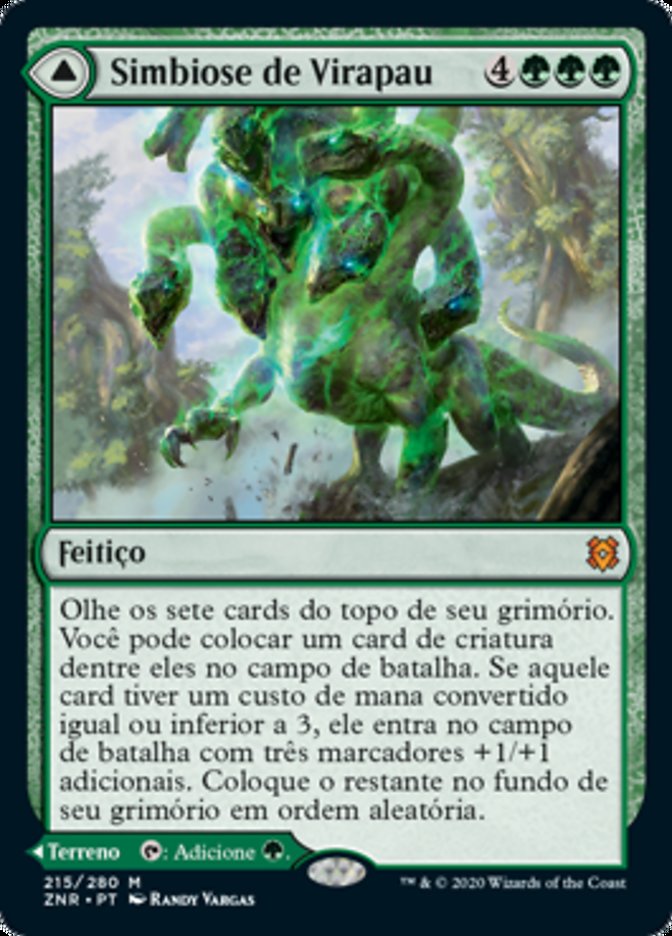

Simbiose de Virapau {4}{G}{G}{G}
Feitiço
Olhe os sete cards do topo de seu grimório. Você pode colocar um card de criatura dentre eles no campo de batalha. Se aquele card tiver um custo de mana convertido igual ou inferior a 3, ele entra no campo de batalha com três marcadores +1/+1 adicionais. Coloque o restante no fundo de seu grimório em ordem aleatória.
Terreno
{T}: Adicione {G}.
Virapau, Mata Serpentina
Terreno
Conforme Virapau, Mata Serpentina, entra no campo de batalha, você pode pagar 3 pontos de vida. Se não fizer isso, ela entrará no campo de batalha virada.
{T}: Adicione {G}.
Feitiço
{4}{G}{G}{G}
“Aqui as árvores se enroscam em aguilhões de mana, alimentando-se do poder que flui por eles.”
— Jori En, líder de expedição
Illustrated by Randy Vargas
- Standard
- Not Legal
- Alchemy
- Not Legal
- Pioneer
- Legal
- Explorer
- Legal
- Modern
- Legal
- Historic
- Legal
- Legacy
- Legal
- Brawl
- Legal
- Vintage
- Legal
- Timeless
- Legal
- Commander
- Legal
- Pauper
- Not Legal
- Oathbreaker
- Legal
- Penny
- Not Legal
Toolbox
Buy This Card
Notes and Rules Information for Simbiose de Virapau // Virapau, Mata Serpentina:
- Only the English version of a Magic card receives Oracle updates and errata. View this card in English. (Scryfall note)
- In the Commander variant, a double-faced card’s color identity is determined by the mana costs and mana symbols in the rules text of both faces combined. If either face has a color indicator or basic land type, those are also considered. (2020-09-25)
- Use the converted mana cost of the creature card as it exists in your library to determine whether it receives +1/+1 counters, ignoring any replacement effects (such as that of Glasspool Mimic) that will change its converted mana cost once it’s on the battlefield. (2020-09-25)
- If a card in a player’s library has {X} in its mana cost, X is considered to be 0. (2020-09-25)
- There is a single triangle icon in the top left corner of the front face. There is a double triangle icon in the top left corner of the back face. (2020-09-25)
- To determine whether it is legal to play a modal double-faced card, consider only the characteristics of the face you’re playing and ignore the other face’s characteristics. (2020-09-25)
- If an effect allows you to play a specific modal double-faced card, you may cast it as a spell or play it as a land, as determined by which face you choose to play. If an effect allows you to cast (rather than “play”) a specific modal double-faced card, you can’t play it as a land. (2020-09-25)
- If an effect allows you to play a land or cast a spell from among a group of cards, you may play or cast a modal double-faced card with any face that fits the criteria of that effect. (2020-09-25)
- The converted mana cost of a modal double-faced card is based on the characteristics of the face that’s being considered. On the stack and battlefield, consider whichever face is up. In all other zones, consider only the front face. This is different than how the converted mana cost of a transforming double-faced card is determined. (2020-09-25)
- A modal double-faced card can’t be transformed or be put onto the battlefield transformed. Ignore any instruction to transform a modal double-faced card or to put one onto the battlefield transformed. (2020-09-25)
- If an effect puts a double-faced card onto the battlefield, it enters with its front face up. If that front face can’t be put onto the battlefield, it doesn’t enter the battlefield. (2020-09-25)
- If an effect instructs a player to choose a card name, the name of either face may be chosen. If that effect or a linked ability refers to a spell with the chosen name being cast and/or a land with the chosen name being played, it considers only the chosen name, not the other face’s name. (2020-09-25)